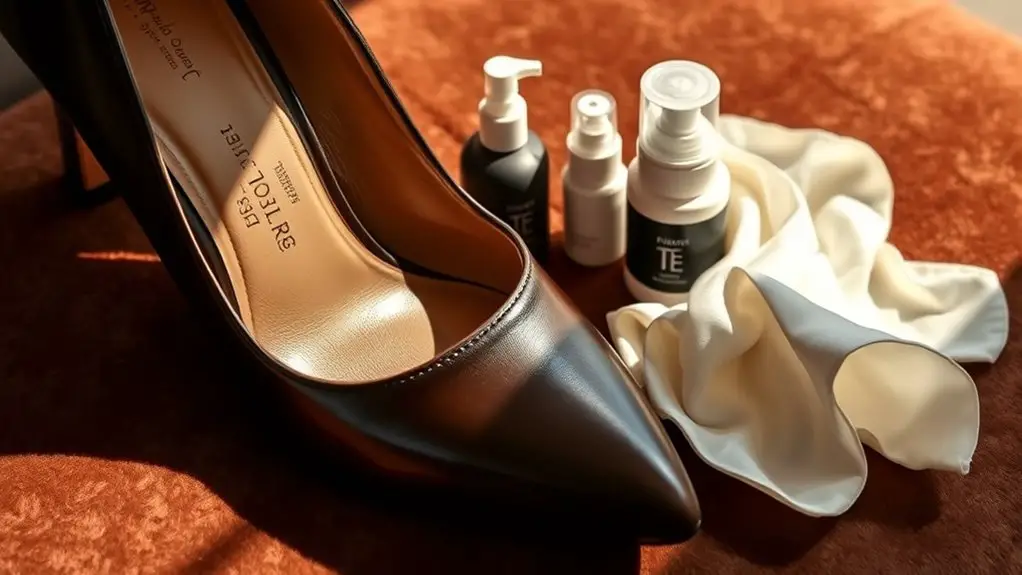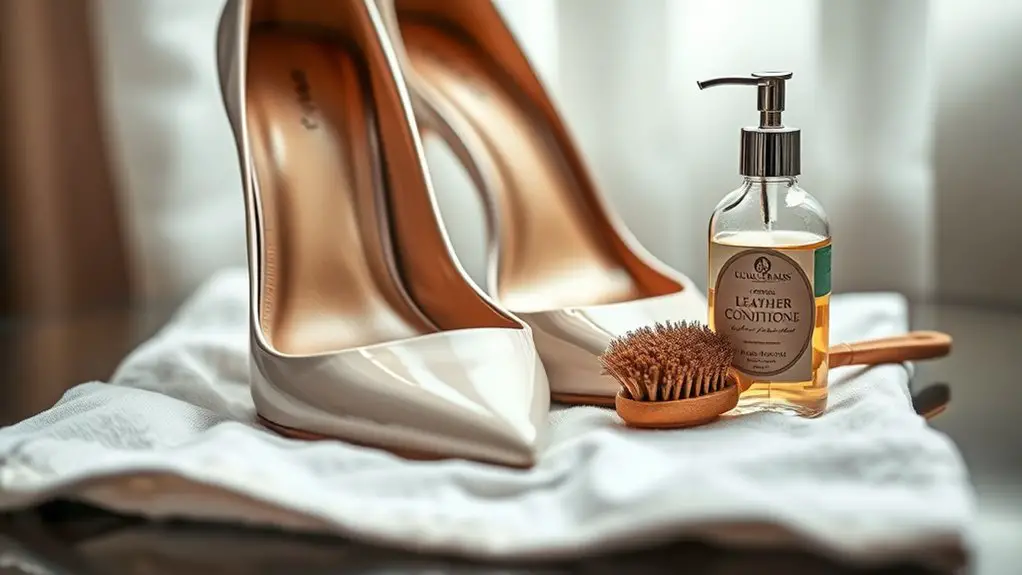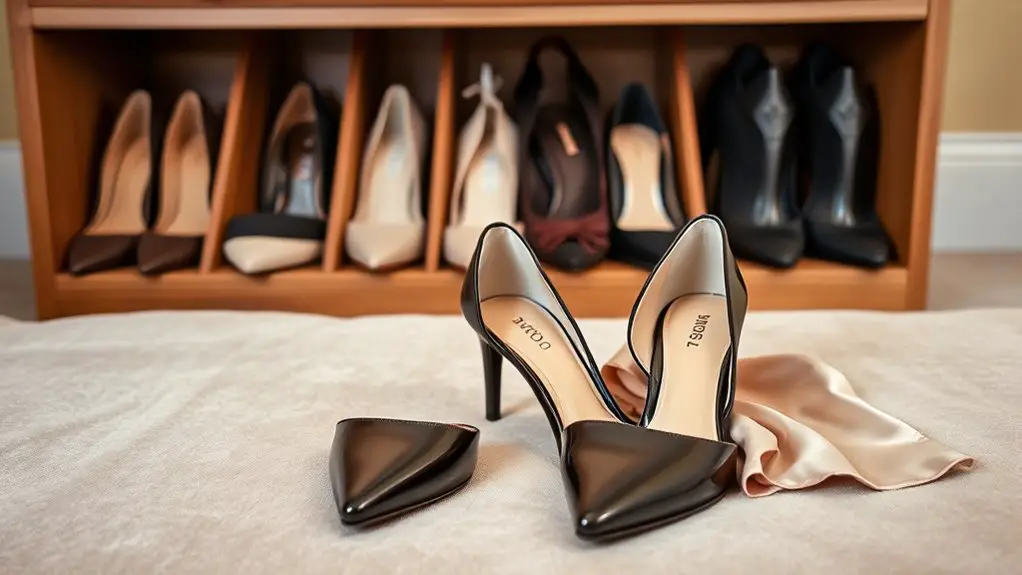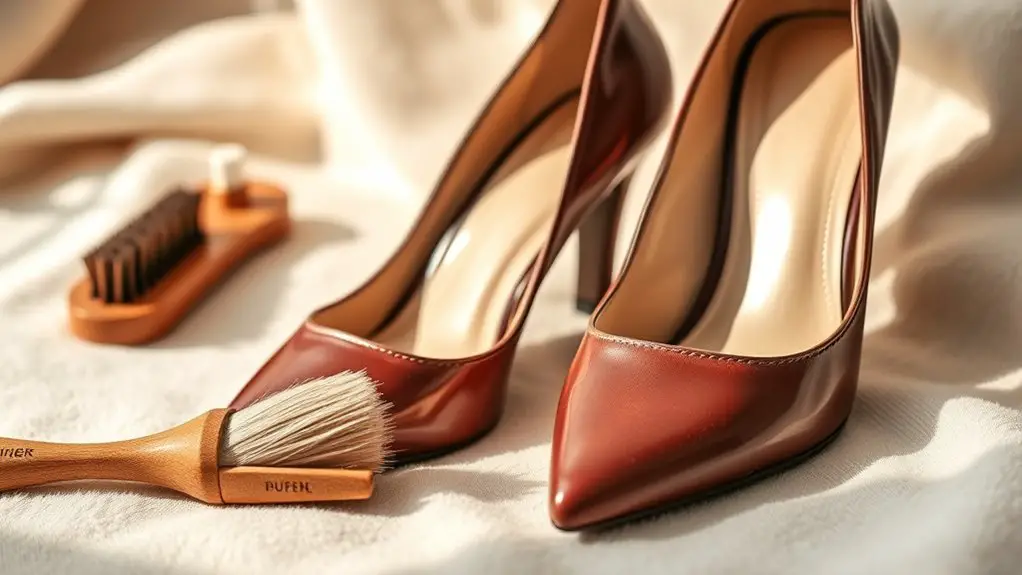To make your heels last longer, focus on quality materials and regular care. Invest in durable leather or well-constructed heels and clean them after each wear to prevent damage. Use protective sprays and store your shoes properly in a cool, dry place to maintain their shape. Schedule repairs as needed, like re-soleing or heel replacements, to keep them in top condition. There are more tips and tricks to guarantee your heels stay fabulous for years.
Choose the Right Materials

When it comes to making your heels last longer, choosing the right materials is vital. Look for high-quality leather, which not only offers durability but also molds to your feet over time. Suede can be stylish, but it requires extra care to prevent staining and wear. Synthetic materials might be budget-friendly, yet they often lack the breathability and longevity of natural options.
Once you’ve selected the ideal material types, proper material care is important. Regularly clean and condition leather to maintain its suppleness and protect against cracking. For suede, a soft brush can help lift dirt without damaging the fabric. Always store your heels in a cool, dry place and use shoe trees to help maintain their shape. By taking these steps, you’ll guarantee that your heels remain not just stylish, but also in good condition for years to come.
Invest in Quality
When you invest in quality heels, you’re not just paying for the brand; you’re ensuring durability and longevity. Look for shoes made from high-quality materials like genuine leather or suede, as these hold up better over time. Additionally, prioritize craftsmanship—well-constructed heels will withstand daily wear and tear much more effectively than cheaper alternatives.
Choose Durable Materials
Although it might be tempting to opt for cheaper options, investing in high-quality, durable materials can greatly extend the life of your heels. When choosing between leather vs synthetic materials, consider that leather generally offers superior durability and breathability. Its ability to mold to your foot shape also enhances comfort. On the other hand, synthetic materials can be more affordable and resistant to water, but they often lack the longevity of leather. Pay attention to other material durability factors like thickness, stitching quality, and flexibility. High-quality rubber or leather soles can provide better traction and wear resistance. Ultimately, selecting durable materials not only preserves the aesthetic appeal of your heels but also saves you money in the long run.
Prioritize Craftsmanship Quality
Investing in high-quality craftsmanship is essential if you want your heels to withstand the test of time. When you prioritize craftsmanship, you’re not just buying a pair of shoes; you’re guaranteeing longevity and comfort. Look for these key elements:
- Materials: Premium leather or suede enhances durability.
- Construction: Go for hand-stitched seams over glued joints for better strength.
- Quality Assurance: Brands that implement rigorous quality checks guarantee you’re getting a reliable product.
- Craftsmanship Techniques: Research the techniques used in production, like Goodyear welting, which offers superior support.
Regular Cleaning and Maintenance

To keep your heels looking pristine and prolong their lifespan, regular cleaning and maintenance are essential. Start by implementing effective cleaning techniques tailored to the material of your heels—use a soft cloth for leather, while suede requires a specialized brush. After each wear, wipe off dirt and dust to prevent buildup, which can damage the surface over time.
Incorporate a routine into your schedule to inspect your heels for any signs of wear. Pay attention to scuffs or loose parts, addressing them promptly. For leather heels, applying a quality conditioner every few months can help maintain their luster and flexibility. If you own suede, consider using a protective spray before wearing them in inclement weather.
Use Protective Products
When you want to keep your heels in top shape, using protective products can make all the difference. These products shield your footwear from damage and extend their lifespan. Here are some essential items to take into account:
- Protective sprays: These create a barrier against dirt and stains, making it easier to clean your heels later.
- Waterproof coatings: Applying these helps prevent water damage, especially on rainy days, keeping your heels looking fresh.
- Sole protectors: These adhesive pads can minimize wear on the soles, providing extra grip and protection on various surfaces.
- Leather conditioners: Regularly moisturizing your leather heels prevents cracking and maintains their luster.
Investing in these protective products not only enhances the durability of your heels but also saves you money in the long run by reducing the need for repairs or replacements. With proper care, your favorite pairs can last for years.
Store Properly

To keep your heels in top shape, storing them properly is essential. Using shoe trees can help maintain their shape, while avoiding heat sources will prevent warping and material damage. Make sure to choose a cool, dry place for storage to extend their lifespan.
Use Shoe Trees
Using shoe trees can greatly extend the life of your heels. By maintaining their shape and absorbing moisture, shoe trees provide essential benefits that keep your footwear looking pristine. Here are some shoe tree types to take into account:
- Wooden Shoe Trees: Ideal for moisture absorption and maintaining shape.
- Plastic Shoe Trees: Lightweight and great for travel, but may not absorb moisture.
- Metal Shoe Trees: Durable and adjustable, perfect for high-end heels.
- Adjustable Shoe Trees: Versatile for various sizes, ensuring a snug fit.
Investing in quality shoe trees is a practical way to preserve your heels, preventing creasing and deformation, ultimately saving you money in the long run. So, don’t skip this vital step in shoe care!
Keep Away From Heat
After ensuring your heels maintain their shape with quality shoe trees, the next step in proper storage involves protecting them from heat. Heat sources like radiators, direct sunlight, and even heating vents can warp or damage the materials of your heels. Store your shoes in a cool, dry place, avoiding areas subject to temperature extremes. A temperature-controlled closet is ideal, as it prevents the leather or fabric from drying out or becoming too pliable. Consider using dust bags or boxes to shield them from ambient heat, as well. By taking these precautions, you’ll prolong the life of your heels considerably, keeping them looking pristine and ready for any occasion.
Limit Wear on Certain Surfaces
While you might love strutting your heels on various surfaces, it’s essential to recognize that some terrains can greatly shorten their lifespan. To keep your beloved heels looking pristine, consider limiting wear on these surfaces:
- Concrete surfaces: The hard texture can cause excessive wear on your heels, leading to scuffing and damage.
- Uneven pavement: Traversing cracks and bumps can stress your shoes, resulting in potential breakage.
- Gravel or rocky areas: These surfaces can chip or scratch your heels, compromising their integrity.
- Wet or slippery floors: Aside from risking falls, moisture can ruin materials, weakening the structure of your shoes.
Opt for softer surfaces like carpeted floors when possible—your heels will thank you! By being mindful of where you wear your heels, you’ll extend their life and enjoy every step in style.
Schedule Repairs as Needed
Even with careful attention to the surfaces you walk on, wear and tear is inevitable for heels. To prolong their lifespan, it’s essential to schedule repairs as needed. Regularly inspect your heels for signs of damage, like worn-out soles or loose components. The frequency of these repairs largely depends on how often you wear your heels and the surfaces you walk on. If you notice any issues, don’t wait; address them promptly to prevent further damage.
When it comes to repairs, consider seeking professional services specialized in shoe restoration. They can expertly handle everything from re-soleing to heel replacement, ensuring your shoes remain in top condition. Creating a maintenance schedule can also help you keep track of when repairs are due. By being proactive about repairs, you’ll not only extend the life of your heels but also maintain their appearance, keeping your footwear looking fabulous for years to come.
Frequently Asked Questions
How Often Should I Clean My Heels?
You wouldn’t want your heels to feel neglected, would you? Aim for a cleaning frequency of once every few wears. Establishing a maintenance schedule helps keep them looking pristine and extends their elegance over time.
Can I Wear Heels in the Rain?
Wearing heels in the rain isn’t ideal, but if you must, consider waterproofing techniques like sprays. Alternatively, choose rainy day options like stylish boots to keep your feet dry and your heels looking great.
What Is the Best Way to Remove Scuff Marks?
Think of your heels as a canvas; scuff marks can mar their beauty. For effective scuff removal techniques, use gentle cleaning products like baking soda or a magic eraser, restoring your shoes’ elegance effortlessly.
How Do I Know When to Replace My Heels?
You’ll know it’s time to replace your heels when you see visible wear, loose components, or significant discomfort. Generally, a heel’s lifespan varies, but these signs indicate that replacement is essential for your comfort and style.
Are There Specific Heel Types That Last Longer?
Did you know stiletto heels can wear down 50% faster than block heels? For durability, opt for block heel longevity; they provide better support and stability, making them a practical choice for lasting wear and comfort.



